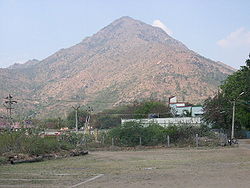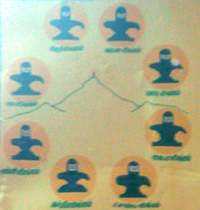- Arunachala
-
Arunachala location of Arunachala in Tamil Nadu Location Location Tiruvannamalai district, Tamil Nadu, India Coordinates 12°08′N 79°19′E / 12.14°N 79.32°ECoordinates: 12°08′N 79°19′E / 12.14°N 79.32°E Arunachala refers to the holy hill at Thiruvannamalai in Tamil Nadu, where the Annamalaiyar Temple, a temple of Lord Shiva is located. Every year in the Tamil month of Karthigai (October–November), the Karthigai Deepam (Light) is lit atop the hill. This place is also known by the names Arunagiri, Annamalai Hill, Arunachalam, Arunai, Sonagiri and Sonachalam. It is the most important holy place for people practicing Atma vichara (self enquiry) and one of the 5 main shaivite holy places in South India. The ashram of Sri Ramana Maharishi, Sri Ramana Ashram is also situated at its foothills.
Contents
References to Arunachala in religious texts
According to the legend, associated with the Temple, a dispute occurred between Brahma the creator, and Vishnu the preserver, over which of them was superior. In order to settle the argument, Lord Siva is said to have manifested as a column of light, and then the form of Arunachala.[1]
In the Maheswara Khanda of Skanda Purana, sage Veda Vyasa describes in great detail the wonder of Arunachala.[2]
Over the centuries, many saints and sages have been drawn to Arunachala. The Saivite saints Manickavachagar, Appar, Sambandar and Sundarar are four examples. In the fifteenth century, Guhai Namasivaya, Guru Namasivaya and Virupaksha Deva came from Karnataka and settled on Arunachala.[1] Saint Namasivaya lived in one of Arunachala's caves which is still known by his name. Virupaksha Deva lived in an OM-shaped cave higher up on the Hill, and this cave too still bears his name.[3] Located on the south-east slope of Arunachala, this was the cave that Sri Ramana Maharshi lived in from 1899 to 1916.[4]
Arunachala Mahatmyam says,
- "By seeing Chidambaram, by being born in Tiruvarur, by dying in Kasi, or by merely thinking of Arunachala, one will surely attain Liberation."
Another verse in the Arunachala Mahatmyam, translated from Sanskrit into Tamil by Sri Ramana Maharshi says:
- "Arunachala is truly the holy place. Of all holy places it is the most sacred! Know that it is the heart of the world. It is truly Siva himself! It is his heart-abode, a secret kshetra. In that place the Lord ever abides the hill of light named Arunachala."[5]
Asked about the special sanctity of Arunachala, Ramana Maharshi said that other holy places such as Kailas[disambiguation needed
 ], Kasi and Chidambaram are sacred because they are the abodes of Lord Siva whereas Arunachala is Lord Siva himself.[6][7] However, as the above verse of Arunachala Mahatmyam says, Arunachala is a secret kshetra. It is this place that bestows jnana (Self-knowledge) and because most people have so many other desires and do not truly want jnana, Arunachala has always remained comparatively little known. But to those few who seek jnana, Arunachala always makes itself known through some means or other.
], Kasi and Chidambaram are sacred because they are the abodes of Lord Siva whereas Arunachala is Lord Siva himself.[6][7] However, as the above verse of Arunachala Mahatmyam says, Arunachala is a secret kshetra. It is this place that bestows jnana (Self-knowledge) and because most people have so many other desires and do not truly want jnana, Arunachala has always remained comparatively little known. But to those few who seek jnana, Arunachala always makes itself known through some means or other.- "All stones in that place [Arunachala] are lingams. It is indeed the abode of Lord Siva. All trees are the wish-granting trees of Indra's heaven. Its rippling waters are the Ganges, flowing through our Lord's matted locks. The food eaten there is the ambrosia of the Gods. When men move about in that place it is the earth performing pradakshina around it. Words spoken there are holy scripture, and to fall asleep there is to be absorbed in samadhi, beyond the mind's delusion. Could there be any other place which is its equal?"
Giri Pradakshina/Giri Valam
The circumambulation of Arunachala is known as Giri Pradakshina in Sanskrit and Giri Valam in Tamil. Performing pradakshina of Arunachala is considered to be beneficial in all ways.[10] Typically, pradakshina is done in bare feet, with the Hill on the right. Sri Ramana Maharshi once explained the meaning of the word pradakshina and how it should be done by a devotee: "The letter "Pra" stands for removal of all kinds of sins; "da" stands for fulfilling the desires; "kshi" stands for freedom from future births; "na" stands for giving deliverance through jnana. If by way of Pradakshina you walk one step it gives happiness in this world, two steps, it gives happiness in heaven, three steps, it gives bliss of Satyaloka which can be attained. One should go round either in mouna (silence) or dhyana (meditation) or japa (repetition of Lord's name) or sankeertana (bhajan) and thereby think of God all the time. One should walk slowly like a woman who is in the ninth month of pregnancy."[11]
Throughout the year, pilgrims engage in a practise called giri valam(circumbulation of Annamalaiyar temple and Annamalai hill 14 km in circumference), considered to be a simple and effective form of yoga. The circumbulation is started from the temple with barefoot and is considered a sacrilege.[12] The central government of India asked the Tamil Nadu government through the supreme court to direct the path of girivalam under the provision of the proposed Tamil Nadu Hertiage Conservation Act.[13] There are 8 small shrines of lingams located in the 14 km circumference of the hill, each one associated with the 12 moon signs. These are collectively termed as Ashta Lingam(meaning 8 lingams) and is considered one of the ritual of worship during the girivalam(circumbulation of the hill)[14].
Lingam Moon Sign Indra Lingam Vrishaba,Tula(Taurus,Libra) Agni Lingam Simha(Leo) Yama Lingam Vrichiga(Scorpio) Niruthi Lingam Mesha(Aries) Varuna Lingam Magara,Kumba(Capricorn), Aquarius) Vayu Lingam Kadaga(Cancer) Kubera Lingam DhanushMeena(Sagittarius, Pisces) Eesaniya Lingam Mithuna, Kanni(Gemini, Virgo) Karthigai Deepam
Every year, on the tenth day of the celebration of Karthikai, devotees take embers in pots from the sacred fire lit in the Arunachaleswara temple and carry them to the top of Arunachala, along with cloth wicks. An enormous cauldron is placed on the highest of Arunachala's five peaks and filled with hundreds of gallons of ghee mixed with camphor. At precisely six o'clock, as the sun sets and the full moon rises, lights are lit on the top of the Hill, on a flagstaff in the temple, and at Sri Ramanasramam, accompanied by chants of Arunachala Siva by the vast crowds.[1] The fire on top of Arunachala can be seen for miles around. Sri Ramana Maharshi described the meaning of this event in this way:
- "Getting rid of the `I am the body' idea and merging the mind into the Heart to realize the Self as non-dual being and the light of all is the real significance of darshan of the beacon of light on Annamalai, the centre of the universe."[15]"
Temple
The temple is famous for its massive gopurams, some of which reach as high as 66m. It is made up of three nested rectangular walls each of which was built during different periods; the innermost could have been built as early as the 11th century. It was later refurbished by the kings of the Vijayanagara empire from 14th through the 17th century. The temple is renowned for some of the remarkable carvings on the walls. In one particular carving Lord Shiva is shown as dancing in an elephant's skin.[16]
Notes
- ^ a b c A. R. Natarajan, Arunachala From Rigveda to Ramana Maharshi
- ^ Veda Vyasa - Skanda Purana. Maheswara Khanda, Arunachala Mahatmya - Book One, Translation and Annotation by Dr. G. V. Tagare
- ^ The Silent Power
- ^ A. R. Natarajan, Timeless in Time, Sri Ramana Maharshi
- ^ James Michael, English translation(1982) "Arunachala Mahatmyam", The Mountain Path, pp. 75-84
- ^ Venkataramiah Munagala (1936) Talks with Sri Ramana Maharshi, (Talk 143), (ISBN 81-88018-07-4) Sri Ramanasramam, Tiruvannamalai html
- ^ Venkataramiah Munagala, (1936) Talks with Sri Ramana Maharshi PDF
- ^ Subramanian M. C., translator (2004) Arunachala Mahatmyam ,THE GLORY OF ARUNACHALA, SRI RAMANASRAMAM TIRUVANNAMALAI pdf
- ^ Jayaraman J., Extract from Sri Arunachala Puranam: , Vignettes
- ^ A. R. Natarajan, Arunachala from Rigveda to Ramana Maharshi
- ^ Suri Nagamma, Letters from Sri Ramanasramam
- ^ Melton 2008
- ^ Gaur 2006, p. 21
- ^ Goodman 2002, pp. 38-39
- ^ Collected Works of Sri Ramana Maharshi
- ^ South India Handbook By Roma Bradnock
External links
- Arunachala pradakshina map
- Live web-cam images of Arunachala
- A collection of writings about Arunachala
- Arunachala Info
- Arunachala video
- Lord Arunachala wallpapers
- Thiruvannamalai Annamalaiyar Details
Categories:- Hindu holy cities
- Hindu temples in Thiruvannaamalai district
Wikimedia Foundation. 2010.



